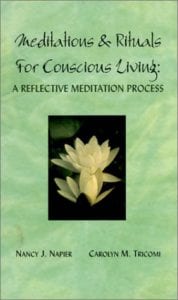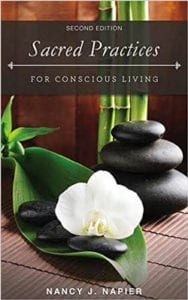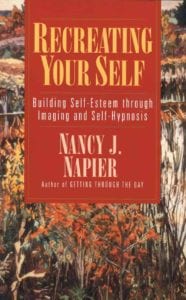Meditations & Rituals For Conscious Living
A Reflective Meditation Process
By Nancy J. Napier and Carolyn M. Tricomi
This book offers a meditation process for conscious living. It invites you to reflect on weekly meditations that allow you to deepen your understanding of themes and practices that bring spiritual experience to life.

Monthly Themes:
- JANUARY • STILLNESS
- FEBRUARY • WHOLENESS
- MARCH • COMPASSION & LOVINGKINDNESS
- APRIL • GETTING GROUNDED
- MAY • MINDFULNESS
- JUNE • GRATITUDE & GENEROSITY
- JULY • ONENESS
- AUGUST • INTENTION
- SEPTEMBER • CREATING POSSIBILITY & SYNCHRONICITY
- OCTOBER • PARADOX
- NOVEMBER • ACTIVE SURRENDER
- DECEMBER • LIVING CONSCIOUSLY
Introduction
Beginning the Journey: An Invitation to the Experience of Reflective Meditation
This book offers a meditation process for conscious living. It invites you to reflect on weekly meditations that allow you to deepen your understanding of themes and practices that bring spiritual experience to life.
Each month represents a meditation theme that develops week by week. Early reflections become the foundation for expanding your experience of the monthly theme. Each week deepens your understanding of the theme and the month ends with a ritual that allows you to bring your meditation to life in practical and grounded ways.
Whereas in mindfulness meditation the goal is to observe what is moving through awareness without attachment, reflective meditation is a process of deep exploration without attachment, a process of deep exploration of ideas and concepts. In this way your ever-deepening contemplation of a particular theme allows it to enter your experience and understanding through images, related concepts, and intuitive insight.
The combination of reflective meditation and ritual provides a foundation for living each day consciously and with an open heart, creating a more alive and vital connection to the world, and to the sacred.
Setting the Space
To begin your practice of reflective meditation, find a place where you have the least amount of distraction, where you can return preferably at the same time of the day each time you meditate. Sit on the floor with your legs crossed or in a chair with your feet on the floor, or in any other position that allows your back to be straight and your body relaxed with your mind alert. You might have paper and pen nearby, in case you want to take notes on the subject of your meditation.
If you are an experienced meditator, meditate for 20 minutes once a day. If you are just beginning, you may find that 20 minutes is too long a time to concentrate on a chosen subject. Begin with whatever period of time feels comfortable to you — starting with five minutes or more — until you work up to a 20 minute meditation. ItÕs find to give more time to the process if you want to do so.
The Importance of Ritual and Ceremony
While we use the term ritual to describe the activities associated with each month’s meditative theme, we could as easily use the word ceremony. For some people, rituals are those activities handed down through a particular tradition which, in themselves, are imbued with power. Ceremonies, then, are those spontaneous creations that celebrate or express some moment, idea, person, or event. For us, the word ritual conveys the conscious, empowered quality that we experience when we participate in symbolic activities. We chose this word because of the power it implies . . . that something real is happening when you participate in this kind of activity. Whichever word most closely matches your experience is fine. The goal is to create and participate in activities that translate spiritual ideas into actual behavior.
Whether called ritual or ceremony, these mindfully chosen activities offer you a means by which you can consciously:
- bring attention and focus to your experience;
- move ideas from abstract into concrete reality;
- acknowledge internal experiences as external expression;
- mark that something — a person, place belief — is significant to you, is worth honoring in a sacred, mindful way;
- slow down and become conscious of how you interact with your world and your day-to-day life;
- experience real acts that affect you and your world, that emerge from and invoke, in themselves, an open heart and an enhanced connection to the world of meaning, to the sacred. . .
Each month’s ritual may be used at the end of the month, after you’ve spent time with the theme. If it feels more powerful to you, though, allow yourself to experience the ritual at any time during the months when you are called to do so. Also, these are suggestions of what a ritual might be. Feel free to change them or create your own. Most important is to engage in experiences that speak to you — to your intention, personal style, and unique relationship to the sacred.
To spend a week contemplating one idea, and then to deepen that idea over a period of three more weeks, gives you an opportunity to go beyond your initial understanding. It allows enough time for you to discover meanings that you may not have anticipated would emerge from your exploration. It is our expectation that by meditating on the concepts encompassed in each month’s meditation theme, by the end of the year you will discover that your spiritual experience and understanding have deepened and expanded in ways that you may not have expected when you initially began the process.

January Meditation : Stillness
January 1— 8: Stillness is the ground of being from which all else emerges. It is within and behind every breath, every thought, every action. It is my starting point, my resting place, the home base to which I return again and again.


